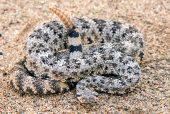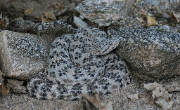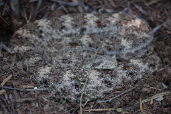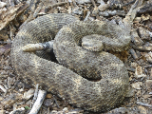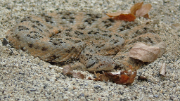Speckled Rattlesnake (Crotalus mitchellii)
Description: Adults are 23-52 inches in length, averaging 2 - 3.5 feet. Young 8.5 - 10.5 inches. Appearance: A long, heavy-bodied pit viper, with a thin neck, a large triangular head, and a rattle on the end of the tail consisting of loose interlocking hollow segments. Pupils are elliptical. Scales are keeled. Rattlesnakes are "pit vipers" which means they have two pits that are used to sense heat when hunting warm-blooded prey - with one pit on each side of the front of the head above the mouth. Color and Pattern: Shows a great variety of body coloration which usually allows the snake to blend into its environment, from off-white, yellowish, gray, tan, pinkish, pale orange, to brown. Snakes from dark lava bed environments can be almost all black.
The body is marked with a vague pattern consisting of dark speckled banded markings. Dark and light rings surround a thick tail. The tail rings are in considerable color contrast with the body color, with the terminal rings being black and with an ash-gray ground color on the tail often present.
Long, hollow, movable fangs connected to venom glands inject a toxic venom which quickly immobilize the prey. The snake can control the amount of venom injected and the fangs are replaced if broken. Bites on humans are potentially dangerous without immediate medical treatment.
Even a dead snake can bite and inject venom if the jaws reflexively open when they are touched.
Habitat: Associated mostly with arid areas strewn with rocks and boulders - alongside buttes, mesas, and desert outcroppings, but sometimes found on loose soil. Occurs in areas vegetated by sagebrush, creosote, thornscrub, chaparral, pinon-juniper woodland, succulent desert.
Range: C. mitchellii is found in the southwestern United States and in northwestern Mexico. In the US, its range includes east-central and southern California, and western Arizona.
Found in these States:
AZ |
CA
Venom: The venom of C. mitchellii is lacking hemorrhagic activity. This venom also had the highest lethal toxicity (i.p. ld50 0.13 – 0.24 mg/kg) in mice, and was the only venom that exhibited a toxin antigenically related to ‘Mojave toxin’.
Diet: Prey consists of small mammals, lizards, and occasionally birds
Reproduction: Rattlesnakes are ovoviparous. The mother keeps her fertilized eggs inside her body and gives birth to living young. Females probably start bearing young at three years of age and breed annually. Mating occurs in the spring. Two to 12 young are born in July or August
Status: Listed as Least Concern in view of its wide distribution, presumed large population, and because it is unlikely to be declining fast enough to qualify for listing in a more threatened category.
»» Kingdom: Animalia - Animals
»» Phylum: Chordata - Chordates
»» Subphylum: Vertebrata - Vertebrates
»» Class: Reptilia - Reptiles
»» Order: Squamata - Scaled Reptiles
»» Suborder: Serpentes
»» Clade: Colubroides
»» Family: Viperidae - Vipers
»» Genus: Crotalus
»» Species: Crotalus mitchellii - Speckled Rattlesnake
»» Subspecies: None
This article uses material from the Wikipedia article "Crotalus mitchellii", which is released under the Creative Commons Attribution-Share-Alike License 3.0. Content may have been omitted from the original, but no content has been changed or extended.
|




